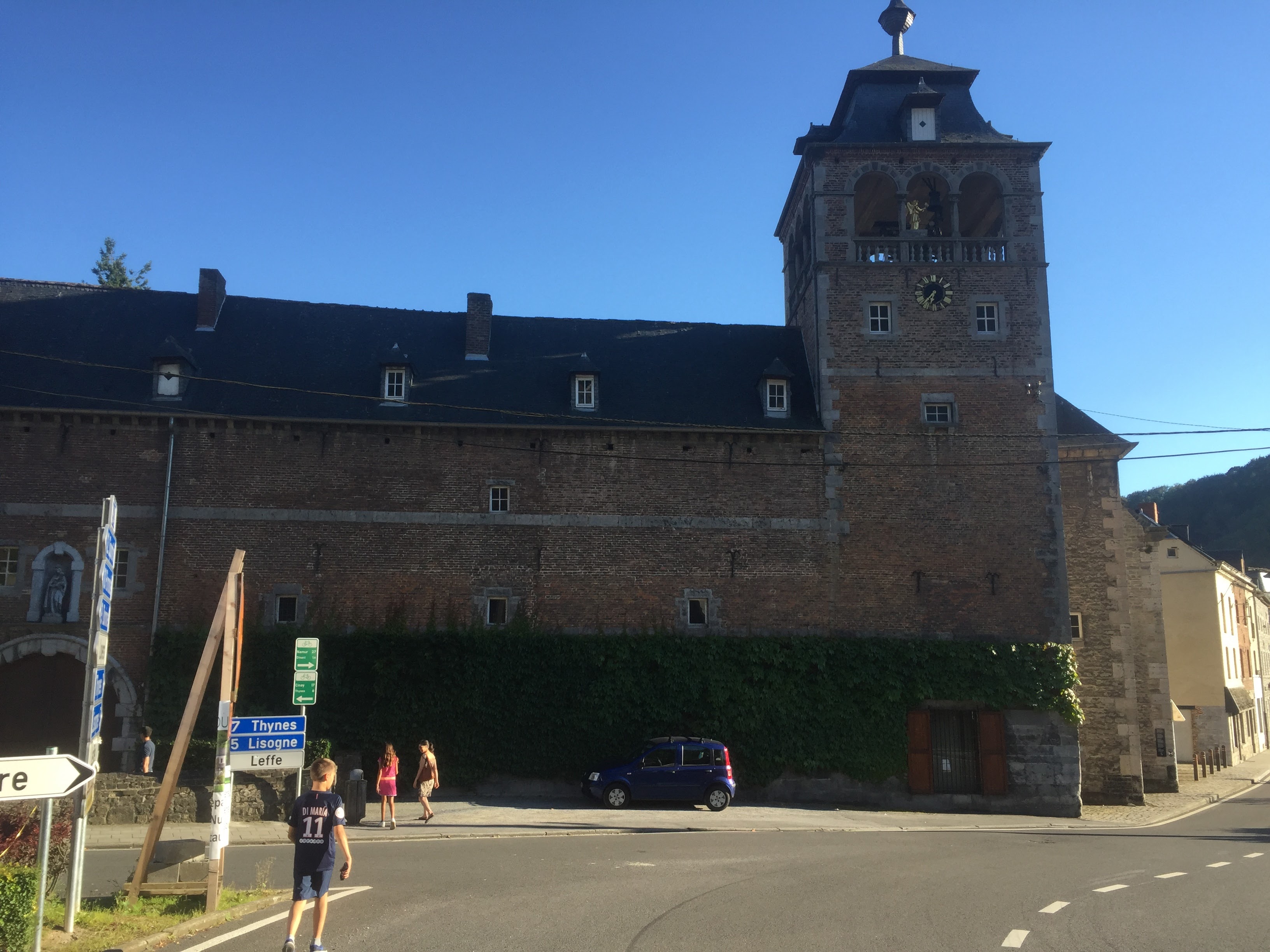|
Overijse
Overijse () is a municipality in the province of Flemish Brabant, in Flanders, Belgium. It is a suburb of the wider Brussels metropolitan area. The municipality comprises the town of Overijse, and the communities of Eizer, Maleizen, Jezus-Eik, Tombeek and Terlanen. On December 31, 2008, Overijse had a total population of 24,410. The total area is 44.43 km² which gives a population density of 549 inhabitants per km². Overijse is surrounded by an extensive woodlands (Zoniënwoud/Forêt de Soignes), with paths for walking and cycling. The official language is Dutch. French-speaking residents who have migrated mainly from Wallonia or Brussels are represented by 8 members on the 27-seat local council. According to the 2008 census, Overijse was also home to 4,842 expatriates including 1,236 Dutch, 766 British, 505 Germans, 375 Americans, 311 French and 295 Italian. Near Overijse there is a medium wave transmitter for the Belgian foreign radio service. Overijse has a traditiona ... [...More Info...] [...Related Items...] OR: [Wikipedia] [Google] [Baidu] |
Druivenkoers Overijse
Druivenkoers Overijse is a single-day road bicycle race held annually in August in Overijse, Belgium. Since 2005, the race is organized as a 1.1 event on the UCI Europe Tour The UCI Continental Circuits are a series of road bicycle racing competitions which were introduced in 2005 by the Union Cycliste Internationale (UCI) to expand cycling around the world. The five circuits (representing the continents of Africa, the .... Winners {{Cycling past winner end External links Official Website UCI Europe Tour races Recurring sporting events established in 1961 1961 establishments in Belgium Cycle races in Belgium Overijse ... [...More Info...] [...Related Items...] OR: [Wikipedia] [Google] [Baidu] |
Vlaamse Druivenveldrit Overijse
The Vlaamse Druivenveldrit is a cyclo-cross race held in Overijse, Belgium. The race is organised by the VZW Sportvrienden Overijse and was first held in 1960. The race is regarded as a Cyclo-cross classic and has a difficult and dangerous parcours that often results in crashes. History Two members of the Overijse cycling club, Frans Vanhoey and Joris Bergiers, originally organized the event in 1960. Up until 1989 the race was usually held twice a year and was held three times in 1975. In addition the Belgian national cyclo-cross championships have been held on the course on five occasions in 1965, 1976, 1983, 1990 and 1996 and were organized by the same organizations. On two occasions a two-man cyclo-cross race or Koppelveldrit was also run on the same course and disputed by professional or elite cyclo-cross riders. In 1974, Roger De Vlaeminck and Frans Verbeeck won and in 1984 Adri van der Poel and Hennie Kuiper won. The 1984 Koppelveldrit was organised as a retirement race for R ... [...More Info...] [...Related Items...] OR: [Wikipedia] [Google] [Baidu] |
Justus Lipsius
Justus Lipsius (Joest Lips or Joost Lips; 18 October 1547 – 23 March 1606) was a Flemish Catholic philologist, philosopher, and humanist. Lipsius wrote a series of works designed to revive ancient Stoicism in a form that would be compatible with Christianity Christianity is an Abrahamic monotheistic religion based on the life and teachings of Jesus of Nazareth. It is the world's largest and most widespread religion with roughly 2.38 billion followers representing one-third of the global pop .... The most famous of these is ''De Constantia'' (''On Constancy''). His form of Stoicism influenced a number of contemporary thinkers, creating the intellectual history, intellectual movement of Neostoicism. He taught at the universities in Jena, Leiden, and Leuven. Early life Lipsius was born in Overijse, Duchy of Brabant, Brabant (in modern Belgium). His parents sent him early to the Jesuit college in Cologne, but they feared that he might become a member of the Society ... [...More Info...] [...Related Items...] OR: [Wikipedia] [Google] [Baidu] |
Jezus-Eik
Jezus-Eik (in French: ''Notre-Dame-au-Bois'') is a village in the municipality of Overijse in the province of Flemish Brabant, Belgium Belgium, ; french: Belgique ; german: Belgien officially the Kingdom of Belgium, is a country in Northwestern Europe. The country is bordered by the Netherlands to the north, Germany to the east, Luxembourg to the southeast, France to th .... File:Jezus Eik, kerk foto11 2011-09-24 11.14.JPG, Onze-Lieve-Vrouwkerk File:O.L.V. Jezus-Eik 801.jpg, Onze-Lieve-Vrouwkerk Populated places in Flemish Brabant Overijse {{FlemishBrabant-geo-stub ... [...More Info...] [...Related Items...] OR: [Wikipedia] [Google] [Baidu] |
Halle-Vilvoorde Administrative Arrondissement
The Halle-Vilvoorde Arrondissement () is one of the two administrative arrondissements in the Belgian province of Flemish Brabant. It almost completely surrounds the Brussels-Capital Region and lies to the west of the other arrondissement in the province, the Leuven Arrondissement. Unlike the Arrondissement of Leuven, it is not a judicial arrondissement; however since the sixth Belgian state reform in 2012–14, it has its own public prosecutor's service. The Halle-Vilvoorde Arrondissement and the Brussels-Capital Region together formed the Brussels-Halle-Vilvoorde electoral district and the Judicial Arrondissement of Brussels. Following the 2007 federal election, Yves Leterme, who is in charge of the negotiations for forming a new Federal Government, proposed to split up the Judicial Arrondissement of Brussels into two judicial arrondissements: one comprising Halle-Vilvoorde and the other comprising the Brussels Region. History The Arrondissement of Halle-Vilvoorde was establi ... [...More Info...] [...Related Items...] OR: [Wikipedia] [Google] [Baidu] |
Flemish Brabant
Flemish Brabant ( nl, Vlaams-Brabant ; french: Brabant flamand ) is a province of Flanders, one of the three regions of Belgium. It borders on (clockwise from the North) the Belgian provinces of Antwerp, Limburg, Liège, Walloon Brabant, Hainaut and East Flanders. Flemish Brabant also surrounds the Brussels-Capital Region. Its capital is Leuven. It has an area of which is divided into two administrative districts (''arrondissementen'' in Dutch) containing 65 municipalities. As of January 2019, Flemish Brabant has a population of 1,146,175. Flemish Brabant was created in 1995 by the splitting of the former province of Brabant into three parts: two new provinces, Flemish Brabant and Walloon Brabant; and the Brussels-Capital Region, which no longer belongs to any province. The split was made to accommodate the eventual division of Belgium in three regions (Flanders, Wallonia and the Brussels-Capital Region). The province is made up of two arrondissements. The Halle-Vilvoorde Arr ... [...More Info...] [...Related Items...] OR: [Wikipedia] [Google] [Baidu] |
Leffe
Leffe () is a premium beer brand owned by InBev Belgium, the European operating arm of the global Anheuser–Busch InBev brewery giant. There are several beers in the range, and they are marketed as abbey beers. They are brewed in large quantities and are widely distributed. History The abbey of Leffe was founded in 1152 on the river Meuse in the province of Namur in southern Belgium. Like many monasteries across Europe, the Premonstratensian (Norbertine) canons of the brewed ale, starting in 1240. Using knowledge passed from generation to generation and ingredients found in the wild near the abbey, the canons developed a unique ale with a subtle taste and high alcohol content, brewed only at the abbey. The abbey has been damaged by both natural and human circumstances over the years: it was destroyed by a flood in 1460, a fire swept through the settlement in 1466, billeted troops damaged the brewery in 1735, and the outbreak of the French Revolution in 1794 resulted in i ... [...More Info...] [...Related Items...] OR: [Wikipedia] [Google] [Baidu] |
Romanesque Architecture
Romanesque architecture is an architectural style of medieval Europe characterized by semi-circular arches. There is no consensus for the beginning date of the Romanesque style, with proposals ranging from the 6th to the 11th century, this later date being the most commonly held. In the 12th century it developed into the Gothic style, marked by pointed arches. Examples of Romanesque architecture can be found across the continent, making it the first pan-European architectural style since Imperial Roman architecture. The Romanesque style in England and Sicily is traditionally referred to as Norman architecture. Combining features of ancient Roman and Byzantine buildings and other local traditions, Romanesque architecture is known by its massive quality, thick walls, round arches, sturdy pillars, barrel vaults, large towers and decorative arcading. Each building has clearly defined forms, frequently of very regular, symmetrical plan; the overall appearance is one of simplic ... [...More Info...] [...Related Items...] OR: [Wikipedia] [Google] [Baidu] |
Gothic Architecture
Gothic architecture (or pointed architecture) is an architectural style that was prevalent in Europe from the late 12th to the 16th century, during the High and Late Middle Ages, surviving into the 17th and 18th centuries in some areas. It evolved from Romanesque architecture and was succeeded by Renaissance architecture. It originated in the Île-de-France and Picardy regions of northern France. The style at the time was sometimes known as ''opus Francigenum'' (lit. French work); the term ''Gothic'' was first applied contemptuously during the later Renaissance, by those ambitious to revive the architecture of classical antiquity. The defining design element of Gothic architecture is the pointed or ogival arch. The use of the pointed arch in turn led to the development of the pointed rib vault and flying buttresses, combined with elaborate tracery and stained glass windows. At the Abbey of Saint-Denis, near Paris, the choir was reconstructed between 1140 and 1144, draw ... [...More Info...] [...Related Items...] OR: [Wikipedia] [Google] [Baidu] |
Christoffel Plantijn
Christophe Plantin ( nl, Christoffel Plantijn; – 1 July 1589) was a French Renaissance humanist and book printer and publisher who resided and worked in Antwerp. Life Plantin was born in France, probably in Saint-Avertin, near the city of Tours, Touraine. He was not born to a wealthy family, and his mother died when Plantin was still quite young. As a youth he apprenticed as a bookbinder in Caen, Normandy, and also married there. In 1545, he and his wife, Joanna Rivière, set up shop in Paris, but after three years they chose to relocate to the booming commercial center of Antwerp, where Plantin became a free citizen and a member of the Guild of St Luke, the guild responsible for painters, sculptors, engravers and printers. The quality of his work as a bookbinder brought him into contact with nobility and wealth. By 1549, he headed one of the most well-respected publishing houses in Europe. He was responsible for printing a wide range of titles, from Cicero to religious hymn ... [...More Info...] [...Related Items...] OR: [Wikipedia] [Google] [Baidu] |
Leuven
Leuven (, ) or Louvain (, , ; german: link=no, Löwen ) is the capital and largest city of the province of Flemish Brabant in the Flemish Region of Belgium. It is located about east of Brussels. The municipality itself comprises the historic city and the former neighbouring municipalities of Heverlee, Kessel-Lo, a part of Korbeek-Lo, Wilsele and Wijgmaal. It is the eighth largest city in Belgium, with more than 100,244 inhabitants. KU Leuven, Belgium's largest university, has its flagship campus in Leuven, which has been a university city since 1425. This makes it the oldest university city in the Low Countries. The city is home of the headquarters of Anheuser-Busch InBev, the world's largest beer brewer and sixth-largest fast-moving consumer goods company. History Middle Ages The earliest mention of Leuven (''Loven'') dates from 891, when a Viking army was defeated by the Frankish king Arnulf of Carinthia (see: Battle of Leuven). According to a legend, the city's red ... [...More Info...] [...Related Items...] OR: [Wikipedia] [Google] [Baidu] |



.jpg)

